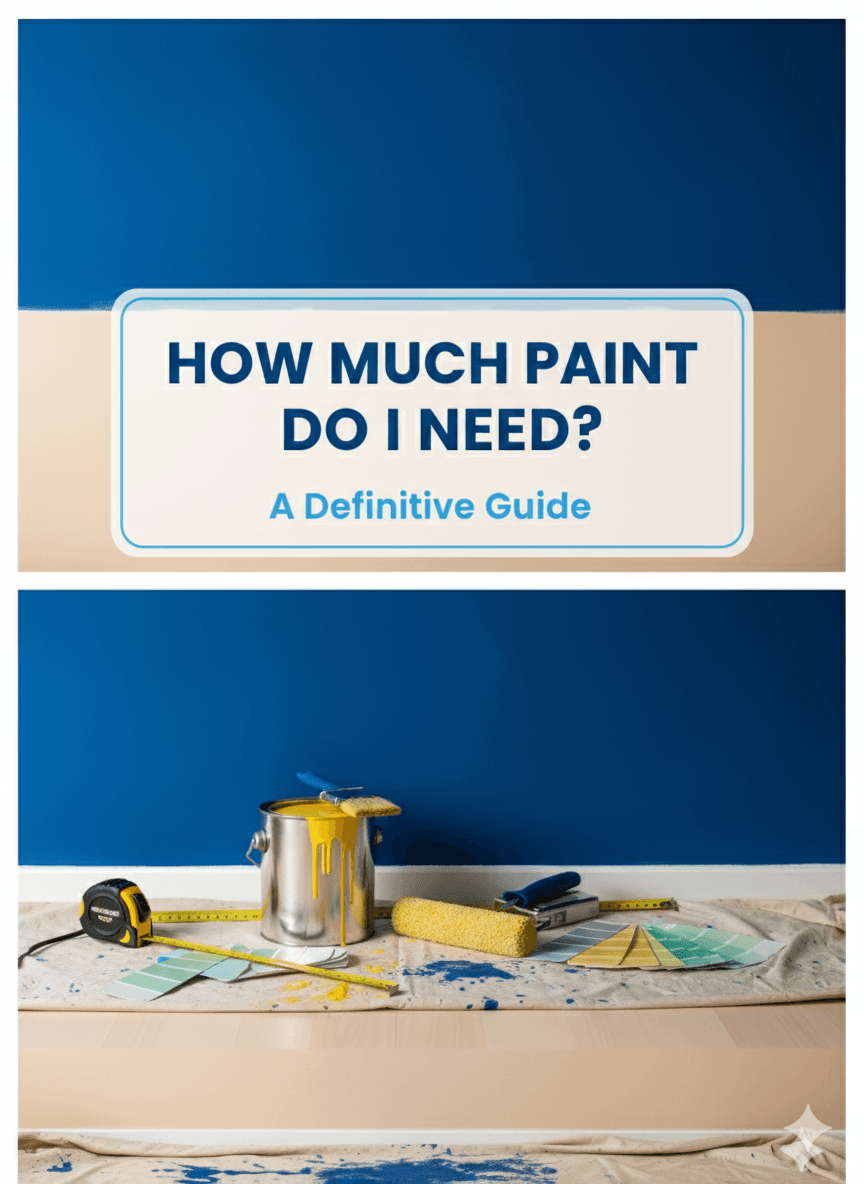How Much Paint Do I Need? A Definitive Guide
Wondering how to calculate your paint needs accurately? This definitive guide answers your questions with formulas, pro tips, and the critical variables that affect paint consumption.

How Much Paint Do You Need?
The Foundation of Paint Estimation: Mastering the Manual Calculation
Accurately estimating the amount of paint required for a project is the cornerstone of a successful, cost-effective, and frustration-free endeavor. Before delving into the complex variables that can influence paint consumption, it is essential to master the fundamental process of manual calculation. This foundational skill transforms a seemingly daunting task into a series of logical, manageable steps.
1.1 Step-by-Step Guide to Measuring Your Space
The accuracy of any paint calculation is directly proportional to the precision of the initial measurements. For this task, a high-quality, retractable metal tape measure is the standard. For greater speed and accuracy, particularly in larger rooms, a laser distance measurer is an excellent alternative.

The guiding principle is to measure each dimension at least twice to confirm the numbers. For non-standard layouts (like L-shapes), break the space down into smaller, regular shapes (rectangles and triangles), calculate the area of each section individually, and then add them together.
1.2 The Core Formula for Walls and Ceilings
With accurate measurements, the next step is to calculate the total surface area.
-
For Walls:
-
Calculate the Perimeter: Add the lengths of all walls together. (For a rectangle: Perimeter = 2 x Length + 2 x Width)
-
Measure the Height: Measure the vertical distance from the floor to the ceiling.
-
Calculate Total Wall Area: The formula is: Total Wall Area = Perimeter × Height
-
-
For Ceilings:
-
Measure Length and Width: The ceiling dimensions are the same as the floor dimensions.
-
Calculate Total Ceiling Area: The formula is: Total Ceiling Area = Length × Width
-
1.3 Calculating and Subtracting Non-Paintable Areas
To find the true paintable surface area, you must subtract the area of doors and windows.
-
Method 1: The "Rule of Thumb" Approximation For quick estimations, subtract a standard area for each common feature:
-
20 square feet for each average-sized door.
-
15 square feet for each average-sized window.
-
-
Method 2: Precise Measurement For the most accurate calculation, measure the height and width of each door and window, calculate their individual areas, and subtract the true total from the gross wall area.
A Pro Tip: Some professionals advise against subtracting these areas. Leaving them in the calculation provides a convenient, built-in contingency of about 10-15% extra paint for waste, spills, and future touch-ups.
1.4 Calculating Paint for Trim, Baseboards, and Crown Molding
Trim must be calculated separately. The process involves calculating the total linear footage of the trim and multiplying it by its width. The formula is: Trim Area = Total Length of Trim × Width of Trim.
Trim paint is often purchased in smaller quantities, such as quarts, rather than full gallons.
Beyond the Basics: Critical Variables That Influence Paint Consumption

The manual calculation provides a sterile, geometric estimate. However, real-world walls have texture, porosity, and a history that dramatically affects how they accept paint. A professional estimator's true skill lies in their ability to diagnose a surface and predict how these variables will impact paint consumption.
2.1 How Texture and Porosity Affect Paint Absorption
The "400 square feet per gallon" rule is for a best-case scenario: a smooth, sealed, previously painted surface.
-
New/Unpainted Drywall: Fresh drywall is highly porous and acts like a sponge. Applying a topcoat directly will result in a blotchy, uneven finish and will consume an enormous amount of paint. For this reason, applying at least one coat of a dedicated drywall primer is non-negotiable.
-
Textured Surfaces: Any surface with a physical texture (stucco, brick, "popcorn" ceilings) has a greater surface area than a smooth wall. As a reliable guideline, plan to purchase 20% to 50% more paint for a textured surface compared to a smooth one.
2.2 The Color Factor: Estimating for Dramatic Color Changes
-
Light over Dark: When painting a light color over a dark one (e.g., beige over navy blue), the old color will tend to "bleed through." This will almost always require additional coats of paint.
-
Poor Hiding Colors: Certain pigments, particularly those in bright, clean yellows, oranges, and reds, are naturally more transparent. They often require an extra coat to achieve a solid, even appearance. The professional solution is the strategic use of a tinted primer.
2.3 How Premium Paints Can Alter Your Calculation
Premium paints contain a higher volume of "solids" (pigments and binders) than budget-grade paints. This means they generally have better hiding power and can achieve full coverage in fewer coats. A more expensive gallon that saves the time and labor of an entire coat can be more economical in the long run.
2.4 Application Methods: Brush, Roller, and Sprayer Efficiency
-
Brushing and Rolling: This is the most common and efficient method for DIY projects.
-
Paint Sprayers: Airless sprayers are fast but inherently less efficient. A portion of the paint is lost to "overspray," which can increase total paint consumption by 20-30% or more.
-
Roller Nap: A thicker roller cover ("nap") is required for textured surfaces. Thicker naps hold more paint and contribute to higher overall consumption.
The Science of Sheen: How Paint Finish Affects Coverage and Durability

The choice of paint sheen is often treated as a purely aesthetic decision. However, the level of gloss has profound technical implications. There is a fundamental trade-off: properties that make a paint finish easy to apply and hide flaws are inversely related to the properties that make it durable and easy to clean.
3.1 Understanding the Sheen Spectrum
-
Flat / Matte: The least reflective finish, absorbing light.
-
Eggshell: A very low luster.
-
Satin: A smooth, velvety sheen.
-
Semi-Gloss: A clearly visible, radiant shine.
-
High-Gloss: A brilliant, highly reflective finish.
The science lies in the paint's formulation. Flatter paints are packed with pigment, which creates a rough surface that scatters light and hides imperfections well. Glossier paints contain far more binder (the resin), which forms a smooth, hard film that reflects light and is highly durable.
3.2 The Inverse Relationship: Why Lower Sheen Means Better Coverage
-
Coverage: Because flat and matte paints are so densely packed with pigment, they have superior hiding power and can cover a surface more effectively with fewer coats.
-
Durability: The high binder content in glossier paints creates a hard, resilient, and non-porous film, making them extremely durable, scrubbable, and resistant to moisture.
3.3 Balancing Aesthetics and Practicality: Choosing the Right Finish
-
Ceilings: Flat paint is the universal choice to prevent glare and hide imperfections.
-
Low-Traffic Areas (Living Rooms, Adult Bedrooms): Flat, matte, or eggshell finishes are excellent.
-
High-Traffic Areas (Hallways, Kids' Rooms): Eggshell and satin represent the ideal compromise, offering better durability than flat.
-
Moisture-Prone & Hard-Working Areas (Kitchens, Bathrooms, Trim): Semi-gloss and high-gloss are the most practical choices for their durability and resistance to moisture.
Key Takeaways from Further Sections:
-
The Power of Primer (Section 4): Primer is a non-negotiable, cost-saving tool for new drywall, dramatic color changes, covering stains, and painting over glossy surfaces. Primer is cheaper than paint and reduces the number of expensive topcoats needed. A tinted primer is a professional secret for helping rich or vibrant colors achieve their true hue in fewer coats.
-
Using Digital Tools (Section 5): Online paint calculators are useful for getting a quick baseline surface area calculation, but they are not a substitute for your own diagnostic assessment. Use them as a starting point, then manually adjust the estimate based on your room's texture, color change, and chosen sheen.
-
The Art of the Purchase (Section 6): Always buy 10-15% extra paint to account for waste and to have a reserve for future touch-ups. For a perfect match later, you must use paint from the original batch. Store leftover paint in a tightly sealed container in a climate-controlled environment, and label it clearly with the color, room, and date.
-
Pro-Level Planning (Section 7): Always plan for a multi-coat system: one coat of primer (if needed) and two uniform topcoats. Remember to budget for preparation materials like spackle, sandpaper, and high-quality painter's tape, as prep work is the key to a professional-looking finish.

Affiliate Disclosure
Some links on this page are affiliate links. If you purchase a product through these links, I may earn a small commission at no additional cost to you. Thank you for your support!
Tags
Other Articles

3 Flawless Layouts and 5 Real-Life Studio Solutions
Wondering how to arrange furniture in your small apartment? Get 3 fail-proof layouts for narrow living rooms and 5 genius plans for studio apartments.

Studio Apartment Hack: 10 "Cloffice" & WFH Nook Ideas That Save Space
Need a home office in your studio apartment? Discover 10 clever ways to create a WFH nook, including amazing "cloffice" (closet office) hacks.

Best Space-Saving Gifts for Small Apartments?
Wondering what gifts to buy for someone in a small space? Our 2025 guide answers with 30 genius space-saving tech, storage, and furniture ideas.